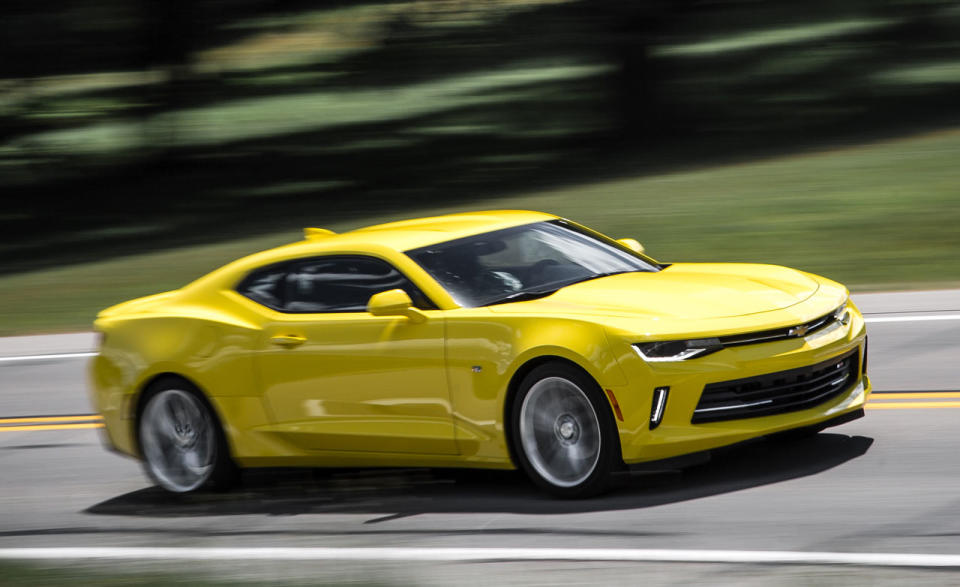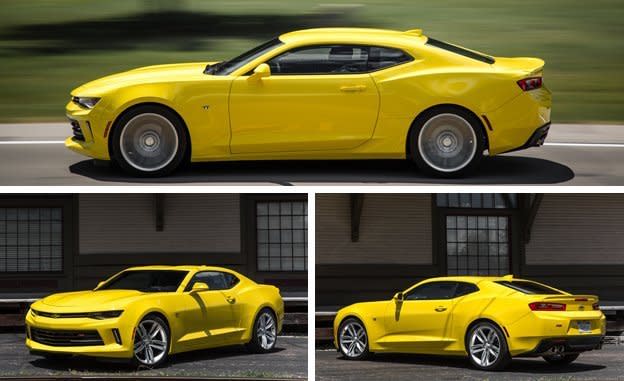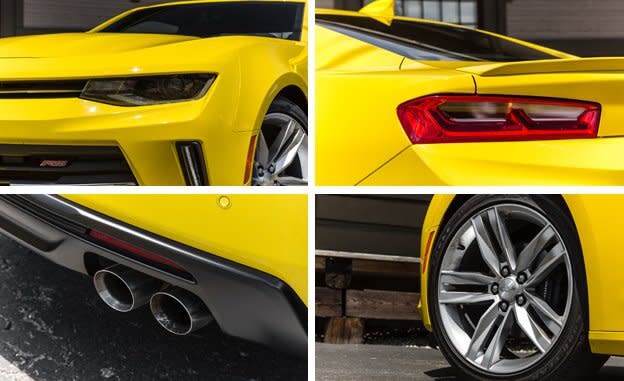2016 Chevrolet Camaro V-6 Automatic

We’ve recently established that there’s no longer any reason to complain if there’s a V-6 under the hood of your Chevrolet Camaro. No snickers, no snide remarks about wimpy pony cars; its inclusion as one of our 2016 10Best Cars is well deserved. So let’s take the exercise a step further: How about a V-6 Camaro with an automatic transmission? Could that be okay, too?
We had a preliminary take on this question last October, when a first drive of a new Camaro V-6 equipped with the eight-speed autobox left us favorably impressed. Now we’ve put a 2016 V-6 automatic (in RS trim) through its paces to fortify those impressions with objective test-track data.

Self-Shifting Virtues
First, the backstory: The V-6 that accompanied the launch of the sixth-generation Camaro is essentially as new as the car itself. Displacement is the same 3.6 liters as in the fifth-gen car, but it’s a bigger 3.6 liters, thanks to a 1.0-millimeter increase in bore and a 0.2-millimeter increase in stroke, to 95.0 by 85.8 mm. As with the Camaro’s 6.2-liter LT1 V-8, the V-6 is an oversquare design—bigger bore than stroke—and is willing to rev; peak horsepower comes on at 6800 rpm, just 200 rpm shy of redline. The compression ratio is high at 11.5:1, the cylinders are nourished by direct injection, and there’s Active Fuel Management (a.k.a. cylinder deactivation) to save gas. And the engine emits a heady tenor snarl when the tach spins past 4000 rpm.
The V-6’s 335 horsepower is 12 ponies more than the previous six-cylinder could muster, and there’s a smidge more torque, too: 284 lb-ft, versus 278. The automatic is GM’s eight-speed 8L45 Hydra-Matic with manual operation via steering-wheel-mounted paddle shifters. There’s also no weight penalty with the automatic, as our 3441-pound test car actually was lighter than the three manual V-6 Camaros we’ve previously evaluated (3467, 3469, and 3484 pounds).
Going by feel, shift speeds seem to be essentially a dead heat between manual and automatic. The Camaro’s Tremec six-speed manual has crisp engagements, and the Hydra-Matic doesn’t hammer home its shifts like a dual-clutch box. Its responses in manual mode seem to be at least on par with those of a competent human.
The V-6 manual Camaros come with a 3.27:1 final-drive ratio and a 0.75:1 top gear. The rear axle with the automatic is 2.77:1, and the eighth-gear ratio is 0.66:1, so it’s geared much taller in top gear than the manual. Also keep in mind that the automatic has two more cogs to play with, which helped our example achieve an observed 22 mpg, whereas we’ve failed to crack 20 mpg with the manual.
Our results reveal the automatic to be very close to the quickest of the three manuals, slower by just a tenth of a second to 60 mph and through the quarter-mile (5.2 and 13.8 seconds, respectively). The auto also recorded a 1-mph edge in trap speed, 104 mph versus 103. And it was quicker across the board than the manual test car that prevailed in a two-car shootout versus a Ford Mustang 2.3-liter EcoBoost.

Other dynamic traits of this Camaro automatic—a 2LT model with the RS package (20-inch wheels with 245/40 Goodyear Eagle F1 Asymmetric All-Season run-flats; HID headlamps; LED taillamps; RS-specific grille; rear deck spoiler)—are indistinguishable from its manual counterpart’s. Turn-in is urgent, with a highly stable attitude in corners and steering that’s quick (2.4 turns lock-to-lock), tactile, and precise. Steering effort might be a little heavy for some tastes—for those, its heft is adjustable—and it’s hard to find fault with its accuracy or with the grip afforded by the thickness of the sporty wheel.
Our only disappointment with this Camaro versus the other V-6 examples had nothing to do with powertrain: The automatic needed 166 feet to stop from 70 mph, which isn’t bad, but the manual cars got it done in 152, 153, and 158 feet. Fade was a non-issue, though.
Automatic Expense
Optional equipment made our test car a little pricey compared with the three manual-transmission models, with $1495 for the slushbox helping to inflate our example’s as-tested price to $40,425. Also, if you’re going to explore the maximum capabilities of this or any other Camaro, you might want to consider some color other than Bright Yellow ($395), a hue that’s surely visible both from low-Earth orbit and from behind the wheel of a police cruiser.

Aside from that price premium, determining whether manipulating shift paddles or snicking through the gates of a manual transmission is the more satisfying experience is something you’ll have to decide for yourself. A bigger decision is probably whether a Camaro will work for you at all, what with its extremely limited visibility, distinct lack of storage space, and minuscule back seat.
But back to the transmission debate: A manual gearbox still provides a greater sense of engagement with the machine. But the eight-speed automatic is more versatile, offering full-auto convenience, better fuel economy when you’re cruising, and manual operation when you’re feeling frisky, without a performance penalty. And best of all, the stigma is gone. For real.
Specifications >
VEHICLE TYPE: front-engine, rear-wheel-drive, 4-passenger, 2-door coupe
PRICE AS TESTED: $40,425 (base price: $29,685)
ENGINE TYPE: DOHC 24-valve V-6, aluminum block and heads, direct fuel injection
Displacement: 223 cu in, 3649 cc
Power: 335 hp @ 6800 rpm
Torque: 284 lb-ft @ 5300 rpm
TRANSMISSION: 8-speed automatic with manual shifting mode
DIMENSIONS:
Wheelbase: 110.7 in
Length: 188.3 in
Width: 74.7 in Height: 53.1 in
Passenger volume: 85 cu ft
Cargo volume: 9 cu ft
Curb weight: 3441 lb
C/D TEST RESULTS:
Zero to 60 mph: 5.2 sec
Zero to 100 mph: 12.5 sec
Zero to 130 mph: 24.7 sec
Rolling start, 5–60 mph: 5.4 sec
Top gear, 30–50 mph: 3.1 sec
Top gear, 50–70 mph: 3.6 sec
Standing ¼-mile: 13.8 sec @ 104 mph
Braking, 70–0 mph: 166 ft
Roadholding, 300-ft-dia skidpad: 0.88 g
FUEL ECONOMY:
EPA city/highway driving: 19/28 mpg
C/D observed: 22 mpg

 Yahoo Autos
Yahoo Autos 